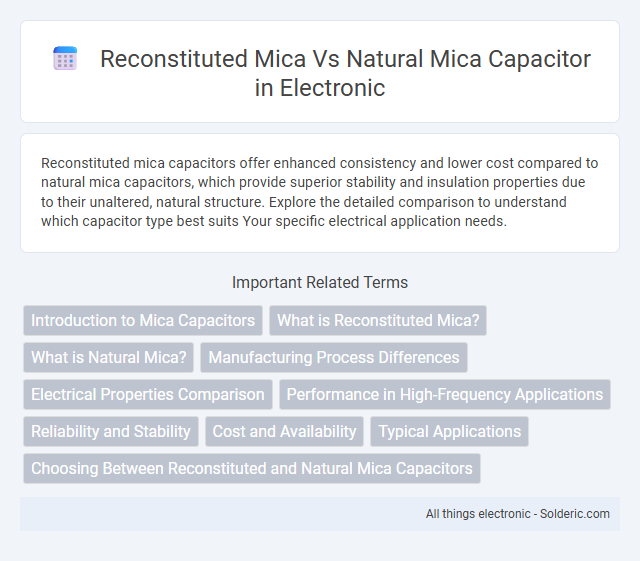Reconstituted mica capacitors offer enhanced consistency and lower cost compared to natural mica capacitors, which provide superior stability and insulation properties due to their unaltered, natural structure. Explore the detailed comparison to understand which capacitor type best suits Your specific electrical application needs.
Comparison Table
| Feature | Reconstituted Mica Capacitor | Natural Mica Capacitor |
|---|---|---|
| Dielectric Material | Reconstituted mica sheets | Natural mica sheets |
| Stability | High stability, close to natural mica | Superior stability and reliability |
| Quality Consistency | More consistent due to controlled manufacturing | Variable, depending on natural source quality |
| Cost | Lower cost, cost-effective | Higher cost, expensive due to natural extraction |
| Availability | Widely available; synthetic production | Limited; dependent on natural mica mining |
| Performance | Excellent electrical properties | Best electrical properties, ideal for high precision |
| Temperature Range | Up to 200degC | Up to 250degC |
| Application | General purpose, RF circuits, industrial | High precision circuits, aerospace, military |
Introduction to Mica Capacitors
Mica capacitors utilize mica as a dielectric material prized for its high dielectric strength and stability, impacting performance characteristics such as low loss and high precision. Natural mica capacitors are made from thin sheets of raw mica, offering superior insulation and durability, while reconstituted mica capacitors are fabricated by bonding mica flakes with resin, providing cost-effective alternatives with good electrical properties. These differences influence their applications in high-frequency circuits, RF oscillators, and precision tuning where reliability and capacitance stability are critical.
What is Reconstituted Mica?
Reconstituted mica is a manufactured dielectric material created by bonding natural mica flakes with resin, offering uniform thickness and enhanced electrical properties for capacitors. Compared to natural mica, reconstituted mica provides improved mechanical strength and consistent capacitance stability, essential for high-frequency and high-voltage applications. Its controlled composition reduces impurities and defects found in natural mica, resulting in better performance and reliability in capacitor manufacturing.
What is Natural Mica?
Natural mica is a mineral composed primarily of silicate sheets, known for its excellent dielectric strength, thermal stability, and resistance to moisture, making it an ideal insulator in capacitors. It is mined directly from mica deposits and undergoes minimal processing, preserving its superior electrical properties and consistent performance in high-frequency and high-temperature applications. Capacitors using natural mica exhibit low loss, high reliability, and long service life compared to those using reconstituted mica, which is manufactured by reprocessing mica flakes and bonding agents.
Manufacturing Process Differences
Reconstituted mica capacitors are made by grinding natural mica into a fine powder that is then mixed with a binding resin and pressed into thin sheets, allowing for more uniform thickness and improved dielectric properties. Natural mica capacitors involve slicing and stacking large, high-quality mica sheets with metal foils, resulting in superior electrical stability but higher material costs and variability due to natural imperfections. Your choice impacts manufacturing consistency, cost efficiency, and capacitor performance based on these fundamental process differences.
Electrical Properties Comparison
Reconstituted mica capacitors exhibit more consistent electrical properties with lower dielectric losses and higher insulation resistance compared to natural mica capacitors, which may experience variability due to natural impurities and structural inconsistencies. The breakdown voltage of reconstituted mica capacitors is typically higher, contributing to improved reliability in high-voltage applications. Temperature stability is enhanced in reconstituted mica, allowing for stable capacitance across a broader temperature range than natural mica.
Performance in High-Frequency Applications
Reconstituted mica capacitors offer superior consistency and stability compared to natural mica capacitors, especially in high-frequency applications where precision is critical. Their engineered structure reduces dielectric loss and permits better performance at higher frequencies, making them ideal for RF and microwave circuits. You benefit from improved reliability and lower signal distortion in demanding electronic environments.
Reliability and Stability
Reconstituted mica capacitors offer enhanced reliability and stability due to their consistent dielectric properties and improved manufacturing control compared to natural mica capacitors. Natural mica capacitors may exhibit variability in performance because of impurities and inconsistencies in the raw mineral sheets. The uniform dielectric thickness in reconstituted mica capacitors contributes to better temperature stability and lower loss, making them more suitable for demanding electronic applications requiring long-term reliability.
Cost and Availability
Reconstituted mica capacitors typically offer lower cost and more consistent availability compared to natural mica capacitors due to synthetic manufacturing processes that reduce material scarcity. Natural mica capacitors depend on mined mica, which is rarer and subject to variable supply chains, often leading to higher prices and limited stock. The synthetic approach in reconstituted mica ensures scalability and stable pricing, making these capacitors more accessible for large-scale electronic applications.
Typical Applications
Reconstituted mica capacitors find typical applications in high-frequency circuits, RF filters, and precision oscillators due to their excellent stability and low loss characteristics. Natural mica capacitors are commonly used in power factor correction, high-voltage applications, and precision timing circuits where their superior dielectric strength and long-term reliability are critical. Your choice between reconstituted and natural mica capacitors depends on the specific requirements of frequency range, voltage rating, and environmental stability in your electronic design.
Choosing Between Reconstituted and Natural Mica Capacitors
Choosing between reconstituted and natural mica capacitors depends on your application's precision and stability requirements. Natural mica capacitors offer superior dielectric stability, low loss, and high reliability, making them ideal for high-frequency and high-precision circuits. Reconstituted mica capacitors provide cost-effective performance with slightly higher tolerance, suitable for less critical applications where budget constraints are a priority.
Reconstituted mica vs natural mica capacitor Infographic

 solderic.com
solderic.com